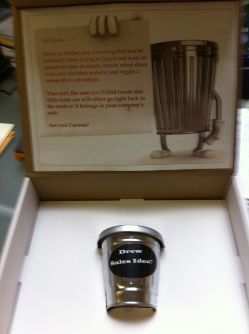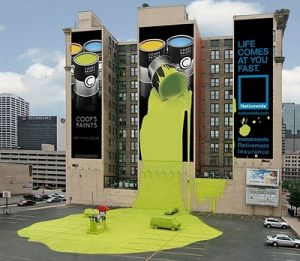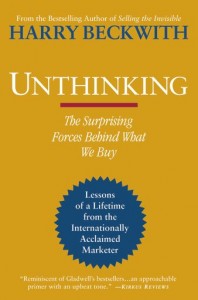Direct mail marketing do’s and don’ts
March 7, 2011
I’ve always been a fan of direct mail, especially 3-D direct mail. It’s pretty tough for someone to ignore a package addressed to them. Assuming you’re mailing to the right audience — it can be very effective.
I get a fair amount of 3-D direct mail related to the blog and my agency McLellan Marketing Group. So I thought we could examine two recent efforts and glean some do’s and don’ts.

A party in a box!
The first mailing came in a huge box and as you can see, it was this metal wash basin, filled with microbrew beers and some snacks. All it needed was some ice and we were ready to go.

My own personalized mini trash can!
The second mailing came in a smaller box and the box itself was part of the message. Inside the box was a small novelty trash can and a personalized message adhered to the inside lid. Inside the trash can was the sales letter. (The teaser copy on the lid directed me to open the trash can.)
Let’s dig into the do’s and don’ts and see how these two efforts fared.
The Do’s:
Address it to the right person: Spell their name correctly and be sure you use the right “version” of their name. My full name is Andrew but no one calls me that. I know that you don’t have a clue who I am if the label says Andrew McLellan instead of Drew McLellan.
Tie what’s in the package to your message: Don’t just send me something random. Help me remember who you are and what you are selling by making the 3-D gift part of the message.
Give me the next step: Once I open the package, it’s my move. So what do you want me to do? Visit a website, send in a bounce back card, call you or wait for you to call me?
The Don’ts:
Don’t do a one and done: No matter how clever your mailing is, remember that in marketing, frequency still matters. So plan a series (you can mix flat and 3-D mailing to keep the budget in line) or tie the 3-D mailing to some other efforts (e-mail, calls, or even mass media).
Put yourself on the list: Unless you are assembling each package by hand, make sure you are on the recipient list. You want to see how it looks from the receiver’s point of view. Did the box get all dinged up? Was everything still in place or had the contents gotten jumbled in transit? Was everything that was supposed to be in the package included?
Don’t let the coy thing play out too far: Teaser campaigns can be a lot of fun. But, they only work if you pay off the tease pretty quickly. Odds are you’ve invested a fair amount of money in this campaign. So don’t waste it by not being clear about who it’s from and what should happen next.
So let’s go back and grade our two examples. The beer basin was addressed correctly, but that’s the only Do it got right. There was no message included in the box. I have no idea who it was from or what they wanted me to do next. Which is a real shame, because I am sure it cost a pretty penny.
On the Don’t list — obviously the coy thing, if the anonymity was intentional, was played out way too long. It’s been a couple weeks and I still haven’t heard another word. Which also means, at this point, it’s a one and done. So while it was an awesome mailing — memorable and something I will remember, it didn’t do much from a direct mail point of view.
On the flip side, the simple trash can mailing, which was clearly less expensive and a little more home grown, got all of the Do’s and Don’ts right. The message and next steps were very clear. I’ve already received an e-mail follow up and the mailing came through with everything in place.
You don’t have to spend an arm and a leg to create an effective 3-D mailing campaign. Far better to do it simply but well. (And if you send me the beer — please let me know so I can say thank you!)
How about you — what’s the most memorable 3-D direct mail piece you ever received?
More











